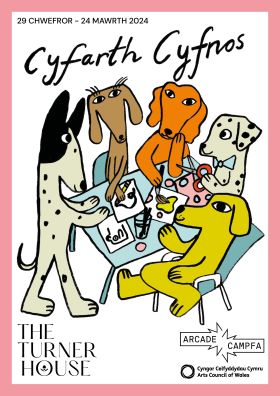Case Study: Twilight Barking
Authors(s), Creator(s) and Contributors: Clare Charles, Co-Director, Arcade Campfa
Publication Date: 18/11/2024
Categories: Case Studies
Partner(s): ArcadeCampfa, Hafan-y-Coed Adult Psychiatric Unit, The Turner House, Pets as Therapy
Funder(s): Arts Council Wales & Cardiff Council via SPF / Levelling Up
Introduction
Twilight Barking (TB) was an ambitious project for inpatients at Hafan-y-Coed Adult Psychiatric Unit. The partnership was established in 2019 as part of Gail Howard and Arcade Campfa's Brief History of Healing. TB is a collaboration with the unit and activities team who facilitated and supported contact with inpatients. The project has been built around a programme of creativity and arts engagement, which explored the human/animal bond, particularly in relation to therapy dogs in hospitals. The project delivered practical workshops at Hafan-y-Coed with Pets as Therapy (PAT) animals in attendance. With the PAT animals being the focus for the art making, the project team has been developing knowledge and experience of the profound benefits of human relationships with animals.
The Challenge
Twilight Barking aimed to sustainably address and alleviate the boredom, agitation, isolation and loneliness caused by long periods of time at the mental health unit. Through the delivery of much needed socially and emotionally supportive, creative outlet, the project explored the positive benefits of the human/animal bond. The project came out of a lived experience of engagement with the mental health unit, and the lack of creative opportunities as an inpatient. The project was designed with the knowledge and skills of the activities team, which led to weekly workshops delivering sustained activity for staff and inpatients, alongside the therapy dogs.
The Approach
The main outputs of Twilight Barking were weekly workshops undertaken with in-patients, staff and artists, which were at the unit. Each artist, plus the organisers, received mental health training with Mind. The project delivered 20 weekly workshops over 6 months, each lasting two hours. Clare and Gail were present at every workshop to facilitate and share delivery of the creative activity with guest artists and a therapy dog with their handler. The focus of each workshop was making artworks that connected with the dogs. Contributing guest artists had lived experience of mental health issues, or previous experience of working with people with low mental health. Patients who were unable to leave the ward were given an activity pack which contained a fuzzy felt kit, notebook, collaging material and glue and card to make gift cards, plus and prompts for creative writing. Each kit included a stamped addressed envelope . Outputs from the workshops, including artworks from patients, staff, and artists were exhibited at Turner House Gallery in Penarth. This included 26 patients, 18 artists, and six public workshops.
The project budget was £40,000 to include paying artists, materials, transport, training, administration, evaluation and the exhibition.
The Impact
The project evaluation used a Theory of Change model. From the initial meeting with Occupational Health staff and the Activities Team we proposed an empirical process of data gathering for noticing and documenting subtle changes in patient engagement within, and shortly after, a Twilight Barking activity. Interviews with staff and weekly reflective journaling enabled the team to adapt and vary conditions incrementally in response to patient experience. Feedback from staff and patient self-report indicated observable changes in patients’ emotion during a session, some directly linked to the dogs and some as a consequence of the creative process. A number of patients returned regularly and showed signs of being less anxious, particularly with the dogs. We introduced new playful techniques, such as weaving to make wearable dog ears and ‘art for dogs’ creating templates for making dog toys from leather, fabric and wool. The latter session was reported to be a successful illustration of the benefits of combining art making with animal contact.
“We’re really going to miss the sessions, sometimes A gets really agitated on the wards and he was always calmer when he came back from the art room. He looks forward to Wednesday, and talks a lot about the dogs as well.”
Lessons Learned
In future iterations it is likely that the project would work with fewer artists in a more in-depth way, therefore deepening the connection but also reducing the amount of support and administration needed to run the project. Sessions would also be shorter, at 1.5 hours, as 2 hours was felt to be tiring for the patients. We would work with artists who already have good experience of working in health settings, as much of the support was around the soft skills of getting used to the environment and the capacity of the patients.
The Legacy
TB evidenced the importance of the human/animal bond. Being with the dogs and watching others provided positive reinforcement, relaxation, generated opportunities to share stories, and stimulated creativity. While we seek further funding we are running monthly sessions with the therapy dog handlers, who are committed to volunteering with the project. The mental health unit is convinced of the benefits to patients and staff, they reported that there is nothing similar for the patients and the positive social impact is clear.
Website and Social Media Links
arcade-campfa.org
gailhoward.net
instagram.com/arcadecampfa
Contact Details
Tags: Mental health, Hafan y Coed, Llandough Hospital, Activity packs, Weaving, Creative Writing, Comics, Fuzzy Felt, Collage, isolation, boredom, Wellbeing, therapy dogs, isolation, inpatient, hospital, visual art, drawing, ceramics, textiles, play, relaxation, socialising

